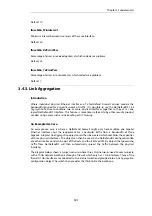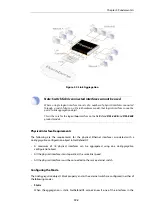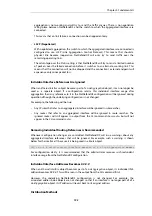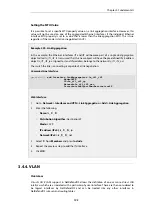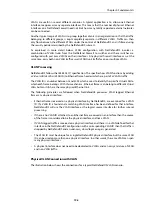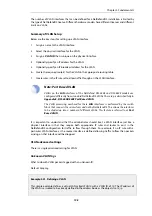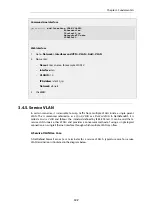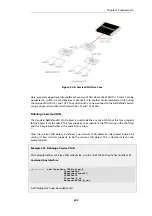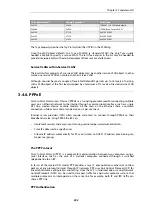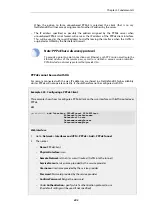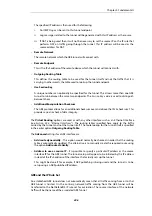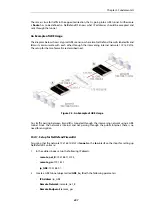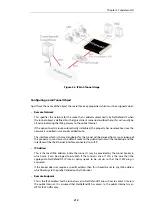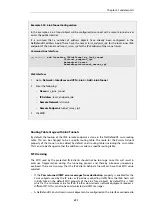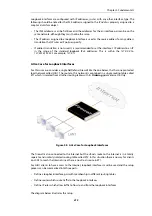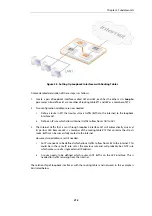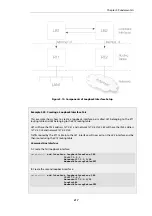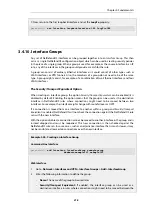
PPP authentication is optional with PPP. Authentication protocols supported are:
Password
Authentication Protocol
(PAP),
Challenge Handshake Authentication Protocol
(CHAP) and
Microsoft
CHAP
(version 1 and 2). If authentication is used, at least one of the peers has to authenticate
itself before the network layer protocol parameters can be negotiated using NCP. During the LCP
and NCP negotiation, optional parameters such as encryption, can be negotiated.
PPPoE Client Configuration
It is possible to run the NetDefendOS PPPoE client over either a physical Ethernet interface or a
VLAN interface.
Each PPPoE tunnel is interpreted as a logical interface by NetDefendOS, with the same routing
and configuration capabilities as regular interfaces and with IP rules being applied to all traffic.
Network traffic arriving at the firewall through the PPPoE tunnel will have the PPPoE tunnel
interface as its source interface. For outbound traffic, the PPPoE tunnel interface will be the
destination interface.
As with any interface, one or more routes are defined so NetDefendOS knows what IP addresses
it should accept traffic from and which to send traffic to through the PPPoE tunnel. The PPPoE
client can be configured to use a service name to distinguish between different servers on the
same network.
IP address information
PPPoE uses automatic IP address allocation which is similar to DHCP. When NetDefendOS
receives this IP address information from the ISP, it stores it in a network object and uses it as the
IP address of the interface.
User authentication
If user authentication is required by the ISP, the username and password can be setup in
NetDefendOS for automatic sending to the PPPoE server.
Dial-on-demand
If dial-on-demand is enabled, the PPPoE connection will only be up when there is traffic on the
PPPoE interface. It is possible to configure how the firewall should sense activity on the interface,
either on outgoing traffic, incoming traffic or both. Also configurable is the time to wait with no
activity before the tunnel is disconnected.
Unnumbered PPPoE
When NetDefendOS acts as a PPPoE client, support for
unnumbered PPPoE
is provided by default.
The additional option also exists to force unnumbered PPPoE to be used in PPPoE sessions.
Unnumbered PPPoE is typically used when ISPs want to allocate one or more preassigned IP
addresses to users. These IP addresses are then manually entered into client computers. The ISP
does not assign an IP address to the PPPoE client at the time it connects.
A further option with the unnumbered PPPoE feature in NetDefendOS is to allow the
specification of a single IP address which is used as the address of the PPPoE client interface. This
address can serve the following purposes:
•
The IP address specified will be sent to the PPPoE server as the "preferred IP". If unnumbered
PPPoE is not forced, the server may choose to not accept the preferred IP and instead assign
another IP address to the PPPoE client.
Chapter 3: Fundamentals
203
Содержание NetDefendOS
Страница 30: ...Figure 1 3 Packet Flow Schematic Part III Chapter 1 NetDefendOS Overview 30 ...
Страница 32: ...Chapter 1 NetDefendOS Overview 32 ...
Страница 144: ...Chapter 2 Management and Maintenance 144 ...
Страница 220: ... Enable DHCP passthrough Enable L2 passthrough for non IP protocols 4 Click OK Chapter 3 Fundamentals 220 ...
Страница 267: ... SourceNetwork lannet DestinationInterface any DestinationNetwork all nets 4 Click OK Chapter 3 Fundamentals 267 ...
Страница 284: ...Chapter 3 Fundamentals 284 ...
Страница 360: ...The ospf command options are fully described in the separate NetDefendOS CLI Reference Guide Chapter 4 Routing 360 ...
Страница 392: ...Chapter 4 Routing 392 ...
Страница 396: ...Web Interface 1 Go to Network Ethernet If1 2 Select Enable DHCP 3 Click OK Chapter 5 DHCP Services 396 ...
Страница 419: ... Host 2001 DB8 1 MAC 00 90 12 13 14 15 5 Click OK Chapter 5 DHCP Services 419 ...
Страница 420: ...Chapter 5 DHCP Services 420 ...
Страница 424: ...2 Now enter Name lan_Access Action Expect Interface lan Network lannet 3 Click OK Chapter 6 Security Mechanisms 424 ...
Страница 573: ...Chapter 6 Security Mechanisms 573 ...
Страница 575: ...This section describes and provides examples of configuring NAT and SAT rules Chapter 7 Address Translation 575 ...
Страница 607: ...Chapter 7 Address Translation 607 ...
Страница 666: ...Chapter 8 User Authentication 666 ...
Страница 775: ...Chapter 9 VPN 775 ...
Страница 819: ...Chapter 10 Traffic Management 819 ...
Страница 842: ...Chapter 11 High Availability 842 ...
Страница 866: ...Default Enabled Chapter 13 Advanced Settings 866 ...
Страница 879: ...Chapter 13 Advanced Settings 879 ...



